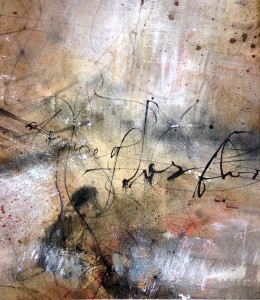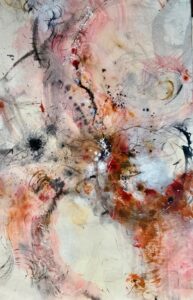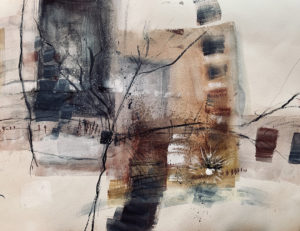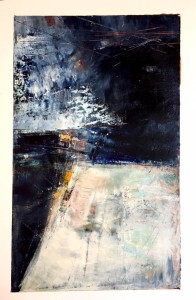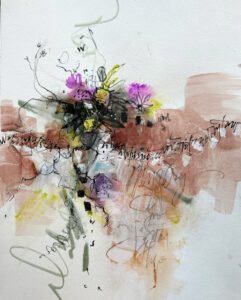
Standing on the top of the mesa an hour before sunset, I watch the angry, dark, indigo sky clear to cloud-puffed blue. The storm ends as quickly as it came up, it’s fierce blustery wind blowing open the ancient windows of the Upper Pavilion to spit droplets of rain on the tables we were covering with butcher paper for our evening exhibit. I feel the usual melancholy of ending a week of Literally Letters at Ghost Ranch. Our stalwart, eclectic group of amateur and professional calligraphers returns year after year to partake in a rare experience of communal art making in a ramshackle building perched like an outcrop on the mesa overlooking the Ranch. In the Upper Pavilion we shed our outer world roles, cares and concerns to take a deep dive into art. It is here, among this community of scribes, where my passion and purpose for pursuing calligraphy was re-ignited. Whether taking late night shots of tequila while flinging sumi ink on paper and rinsing it the ancient sink in the corner of the room; walking the labyrinth at dawn of the Summer solstice: attempting to find a spotty Internet connection in the musty library; sneaking off to Abiquiu for a decent meal; laughing at the sudden gusts of wind spilling dust on our art in the Upper Pavilion; hanging out at the canteen eating ice cream with surly teenagers; walking back to our cabins at two in the morning guided by the light of stars and the moon; or sharing joys and sorrows at evening vespers, all of it adds up to a creative bonanza of art bursting out of our seams during a week of “Ghost Ranch dream time”.
My children have spent many summers here with me. So has my white-haired Mother, who in her elder prime, along with with her friend Rita, year after year risked life and limb traversing steep slopes of the quarry across the road to dig for dinosaur bones with the paleontology group. Back home, the memories formed here will sustain and inspire new art throughout the year, but it always saddens me to leave. Against the backdrop of this ancient New Mexico landscape one is both awed and overwhelmed by the forces of nature that have shaped and carved Ghost Ranch into its current form of canyon, mesa and chimney rock. The storm that had just nearly blown us all away reminds me of how small and vulnerable we humans are in nature’s grand scheme of things: blips on a timeline of eons.
Looking over to Kitchen Mesa, a rainbow appears, rising as if blooming naturally out of the sage-scruffed red cliffs. Inhaling a deep breath of rain freshened air, I imagine similar blue mesa sunset skies and rainbows of ages past, dinosaurs grazing in the surrounding wetlands. A quiet moment of reverie expands to eternity as life flashes before me in waves of grief, joy and wonder: graduations, travel, children grown up, books written, art created, mom’s ashes on this land, my own visage beginning to dull and wrinkle, hands unsteady, calligraphy turned to dust, the wonderful, terrible circle of life unfolding in a fractal, layered movie montage in my head. The heart expansion and gut punch of communing with then saying goodby to Ghost Ranch and my tribe of Literally Letters calligraphers—the living and dying and all that’s in between—- wells up and spills out in tearful, laughing sobs as the blue sky turns sunset pink and fiery orange. A cholla flower I’ve watched all week transform from tight green bud to full outrageous magenta blossom offers its bright petaled smile to complete the colorful dusk scene.
A poem emerges on the spot; a kind of prayer to commemorate this sacred moment which I speak out loud to commit to memory:
A Cholla rose in morning
Yawning magenta
Petals stretch to greet the sun
I return to a transformed Upper Pavilion: now it is a chic, rustic gallery with art tastefully displayed around the room. The floors are swept, art supplies are packed and stowed away, chairs are rearranged, and heaping platters of brownies have just arrived, compliments of the Ghost Ranch kitchen. It is 8:18 and the show begins. Dressed in our finest casual “artsy bohemian” attire, my fellow scribes and I mill about greeting guests who arrive from all corners of Ghost Ranch to see what we calligraphers have gotten up to all week. Some of us offer calligraphy demonstrations, which include gifts of embellished bookmarks created on the spot. Another offers free hand painted arm “tatoos” which delights children and adults alike. One of our tribe inevitably breaks out the “forbidden” wine and beer, and at evening’s end, when the guests have gone, we raise our plastic glasses to toast another memorable week of Literally Letters. As we go outside to watch the full moon rise over the mesa, we extend our arms to each other in tearful, hugged farewells. The Upper Pavilion is dark and quiet when we close the door and turn off the lights.





